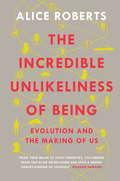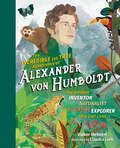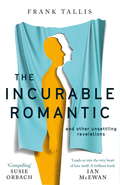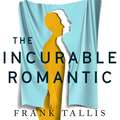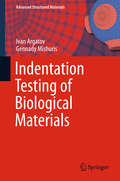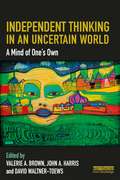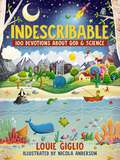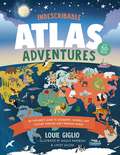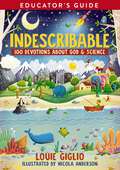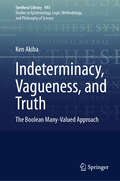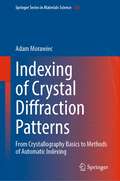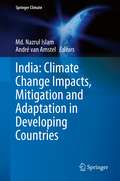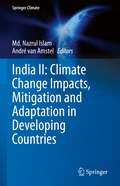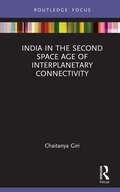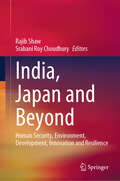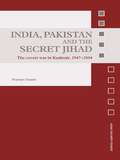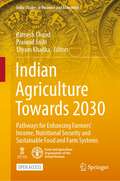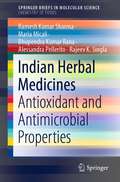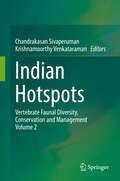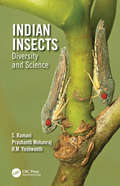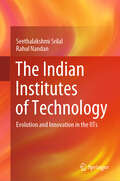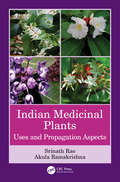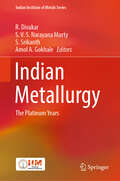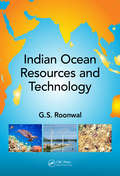- Table View
- List View
The Incredible Unlikeliness of Being: Evolution and the Making of Us
by Alice Roberts'From your brain to your fingertips, you emerge from her book entertained and with a deeper understanding of yourself' Richard Dawkins'A masterful account of why our bodies are the way they are . . . this book really shines . . . Roberts's lightness of touch is joyous, and celebratory' Observer'Witty, personal and above all informed by passion and deep knowledge, this is the story of you, not just from conception onwards but from the millions of years of evolution that have shaped the way we are today' Adam Rutherford***SHORTLISTED FOR THE WELLCOME BOOK PRIZE***Alice Roberts takes you on the most incredible journey, revealing your path from a single cell to a complex embryo to a living, breathing, thinking person. It's a story that connects us with our distant ancestors and an extraordinary, unlikely chain of events that shaped human development and left a mark on all of us. Alice Roberts uses the latest research to uncover the evolutionary history hidden in all of us, from the secrets found only in our embryos and genes - including why as embroyos we have what look like gills - to those visible in your anatomy. This is a tale of discovery, exploring why and how we have developed as we have. This is your story, told as never before.
The Incredible Unlikeliness of Being: Evolution and the Making of Us
by Alice Roberts'From your brain to your fingertips, you emerge from her book entertained and with a deeper understanding of yourself'Richard Dawkins'A masterful account of why our bodies are the way they are . . . this book really shines . . . Roberts's lightness of touch is joyous, and celebratory' Observer'Witty, personal and above all informed by passion and deep knowledge, this is the story of you, not just from conception onwards but from the millions of years of evolution that have shaped the way we are today' Adam Rutherford***SHORTLISTED FOR THE WELLCOME BOOK PRIZE***Alice Roberts takes you on the most incredible journey, revealing your path from a single cell to a complex embryo to a living, breathing, thinking person. It's a story that connects us with our distant ancestors and an extraordinary, unlikely chain of events that shaped human development and left a mark on all of us. Alice Roberts uses the latest research to uncover the evolutionary history hidden in all of us, from the secrets found only in our embryos and genes - including why as embroyos we have what look like gills - to those visible in your anatomy. This is a tale of discovery, exploring why and how we have developed as we have. This is your story, told as never before.
The Incredible yet True Adventures of Alexander von Humboldt: The Greatest Inventor-naturalist-scientist-explorer Who Ever Lived
by Volker MehnertBefore Darwin . . . before Lewis and Clark . . . there was Alexander von Humboldt. Explorer. Naturalist. All-around genius. Lost hero of science. In his time, Alexander von Humboldt (1769–1859) was world-famous. Why? He led one of the first major scientific expeditions into the South American rain forest and another into the wilds of Siberia. Carrying fragile instruments, he navigated perilous rapids and climbed the volcano of Tenerife. He observed animals, plants, and cultures that no one in Europe had ever dreamed of, and his books about them inspired a whole generation of scientists—including Charles Darwin. But before he did any of that, he was a little boy who was curious about everything (especially bugs)! The Incredible yet True Adventures of Alexander von Humboldt will whisk you away to another time and place. Meet the young man who, defying his mother’s wishes, became a daring explorer-scientist—and follow along as he makes his amazing discoveries. Lavish illustrations bring Humboldt’s untamed world to life. See nature through the eyes of a great early scientist. Wonder awaits!
The Incurable Romantic: and Other Unsettling Revelations
by Frank Tallis'Frank Tallis brings a lifetime's clinical experience and wise reflection to a condition that, by its own strange routes, leads us into the very heart of love itself. This is a brilliant, compelling book' Ian McEwanLove is a great leveller. Everyone wants love, everyone falls in love, everyone loses love, and everyone knows something of love's madness. But the experience of obsessive love is no trivial matter. In the course of his career psychologist Dr Frank Tallis has treated many unusual patients, whose stories have lessons for all of us.A barristers' clerk becomes convinced that her dentist has fallen in love with her and they are destined to be together for eternity; a widow is visited by the ghost of her dead husband; an academic is besotted with his own reflection; a beautiful woman searches jealously for a rival who isn't there; and a night porter is possessed by a lascivious demon. These are just some of the people whom we meet in an extraordinary and original book that explores the conditions of longing and desire - true accounts of psychotherapy that take the reader on a journey through the darker realms of the amorous mind.Drawing on the latest scientific research into the biological and psychological mechanisms underlying romance and emotional attachment, The Incurable Romantic demonstrates that ultimately love dissolves the divide between what we judge to be normal and abnormal.
The Incurable Romantic: and Other Unsettling Revelations
by Frank Tallis'Frank Tallis brings a lifetime's clinical experience and wise reflection to a condition that, by its own strange routes, leads us into the very heart of love itself. This is a brilliant, compelling book' Ian McEwanLove is a great leveller. Everyone wants love, everyone falls in love, everyone loses love, and everyone knows something of love's madness. But the experience of obsessive love is no trivial matter. In the course of his career psychologist Dr Frank Tallis has treated many unusual patients, whose stories have lessons for all of us.A barristers' clerk becomes convinced that her dentist has fallen in love with her and they are destined to be together for eternity; a widow is visited by the ghost of her dead husband; an academic is besotted with his own reflection; a beautiful woman searches jealously for a rival who isn't there; and a night porter is possessed by a lascivious demon. These are just some of the people whom we meet in an extraordinary and original book that explores the conditions of longing and desire - true accounts of psychotherapy that take the reader on a journey through the darker realms of the amorous mind.Drawing on the latest scientific research into the biological and psychological mechanisms underlying romance and emotional attachment, The Incurable Romantic demonstrates that ultimately love dissolves the divide between what we judge to be normal and abnormal.
Indentation Testing of Biological Materials (Advanced Structured Materials #91)
by Gennady Mishuris Ivan ArgatovThis book presents a comprehensive and unifying approach to analytical identification of material properties of biological materials. Focusing on depth-sensing indentation testing, pipette aspiration testing, and torsion of soft tissues, it discusses the following important aspects in detail: damping, adhesion, thickness effect, substrate effect, elastic inhomogeneity effect, and biphasic effect. This book is intended for advanced undergraduate and graduate students, researchers in the area of biomechanics as well as for biomedical engineers interested in contact problems and involved in inverse materials parameters prediction analysis.
Independent Thinking in an Uncertain World: A Mind of One’s Own
by Valerie A. Brown John A. Harris David Waltner-ToewsAny effective response to an uncertain future will require independently thinking individuals working together. Human ideas and actions have led to unprecedented changes in the relationships among humans, and between humans and the Earth. Changes in the air we breathe, the water we drink and the energy we use are evidence of Nature – which has no special interest in sustaining human life – looking out for itself. Even the evolutionary context for humans has altered. Evolutionary pressures from the digital communication revolution have been added to those from natural systems. For humans to meet these challenges requires social re-organisation that is neither simple nor easy. Independent Thinking in an Uncertain World explores workable, field-tested strategies from the frontiers of creating a viable future for humans on Earth. Based on research results from hundreds of social learning workshops with communities worldwide, many of them part of Australian National University’s Local Sustainability Project, authors with diverse interests explore the gap between open-minded individual thinking and closed socially defined knowledges. The multiple dimensions of individual, social and biophysical ways of thinking are combined in ways that allow open-minded individuals to learn from one another.
Indescribable: 100 Devotions for Kids About God and Science (Indescribable Kids)
by Louie GiglioDiscover the Wonders of the Universe with the CreatorIt’s impossible to out-imagine God. He orchestrates time, creates light, and speaks things into existence—from the largest stars to the smallest starfish. God is a powerful, purposeful, personal, unparalleled Creator.Psalm 19:1 says, “The heavens tell the glory of God. And the skies announce what his hands have made.”Indescribable displays the majesty of creation with scientific findings, photography, and original illustrations. These 100 devotions encourage awe at God’s creativity with an in-depth look at • Space, Galaxies, Planets, and Stars• Earth, Geology, Oceans, and Weather• Animals—from Hummingbirds to Dinosaurs• Our Minds, Bodies, and Imaginations Each devotion features a “Be Amazed” section with fascinating facts, hands-on activities, and a closing prayer. Based on Louie Giglio’s popular messages “Indescribable” and “How Great Is Our God,” Indescribable: 100 Devotions About God & Science will help kids discover the incredible creation of our indescribable God.
Indescribable Atlas Adventures: An Explorer's Guide to Geography, Animals, and Cultures Through God's Amazing World (Indescribable Kids)
by Louie GiglioWith more than 50 infographic maps, this illustrated world atlas for kids from bestselling author Louie Giglio will stretch your children's understanding of the world as they discover more about God, science, and His amazing world!Indescribable Atlas Adventures offers a self-guided tour for your favorite explorer throughout the seven continents and over 50 countries. Easy-to-read maps, more than 1,500 facts, and a world map that helps kids identify each continent and country will help your child to think globally and discover new insights into God's incredible creation. Each map includesan overview of each country's population, languages, and prominent features;key facts about the country's capital cities; neighboring countries; and the national bird, tree, and dish;notable people and their amazing achievements;the country's terrain, climate, wildlife, contributions to space exploration, cultural hallmarks, and Christian faith traditions; andbiblical and inspirational pieces, like devotional thoughts, prayers, and Bible verses that highlight how amazing God and His world are.Indescribable Atlas Adventures is for ages 6 to 10 and spotlights several fascinating ecosystems, like the Sahara, Amazon, and Great Barrier Reef. This book has a large trim size to help kids explore fun details on each page and is a perfect "my first atlas of the world" gift for curious kids.Check out these other books from Pastor Louie's Indescribable Kids series, which has sold more than a million copies:IndescribableHow Great Is Our GodThe Wonder of CreationIndescribable for Little OnesIndescribable Activity Book for Kids
Indescribable Educator's Guide: 100 Indescribable Devotions About God And Science (Indescribable Kids)
by Louie GiglioIndescribable Educator's Guide is a companion to Indescribable by Louie Giglio. This guide can be utilized in the classroom, in a home school setting, or by parents seeking additional resources. Ideal for grades 3rd-5th.
Indeterminacy, Vagueness, and Truth: The Boolean Many-Valued Approach (Synthese Library #493)
by Ken AkibaThis book shows that the assumption that classical logic is essentially a bivalent (i.e., 2-valued) logic, a logic of truth and falsity, is an incorrect and harmful conception. Classical logic is certainly a Boolean logic, and the smallest (non-degenerate) Boolean algebra is the 2-element Boolean algebra; however, there are numerous Boolean algebras that have more than 2 elements, such as the 4-, 8-, 16-, ..., infinite-element Boolean algebra, and they all work equally well for the semantics of classical logic. Contrary to the popular thought, there is such a thing as classical (or Boolean) many-valued logic. The book applies this logic to solve such philosophical problems as the Fission Problem for personal identity, the Sorites Paradox, and the Liar Paradox. All these problems concern situations that involve indeterminacy or vagueness, situations where there seems 'no fact of the matter' that makes the relevant sentences true or false, thus requiring truth value gaps between truth and falsity. Because of that, classical logic has been thought to be an inadequate tool to deal with the problems. This book, however, offers solutions to those problems by retaining classical logic but assigning intermediate Boolean values to the relevant sentences. The book is of great value to researchers and graduate students in philosophy, especially for those who are interested in the philosophical issues surrounding indeterminacy, vagueness, and truth.
Indexing of Crystal Diffraction Patterns: From Crystallography Basics to Methods of Automatic Indexing (Springer Series in Materials Science #326)
by Adam MorawiecThis book provides a detailed, self-contained description of automatic indexing of crystal diffraction patterns, considering both ab initio indexing and indexing of patterns originating from known structures. Introductory chapters equip the reader with the necessary basic knowledge of geometric crystallography, as well as kinematic and dynamic theories of crystal diffraction. Subsequent chapters delve and describe ab initio indexing of single crystal diffraction patterns and indexing of patterns for orientation determination. The book also reviews methods of indexing powder diffraction and electron spot-type patterns, as well the subject of multigrain indexing. Later chapters are devoted to diffraction by helical structures and quasicrystals, as well as some aspects of lattice parameter refinement and strain determination.The book is intended equally for materials scientists curious about ‘nuts and bolts’ of diffraction pattern indexing and orientation mapping systems, as well as interdisciplinary researchers from physics, chemistry, and biology involved in crystallographic computing. It provides a rigorous, yet accessible, treatment of the subject matter for graduate students interested in understanding the functioning of diffraction pattern indexing engines.
India: Climate Change Impacts, Mitigation and Adaptation in Developing Countries (Springer Climate)
by Md. Nazrul Islam André Van AmstelClimate change will lead to many changes in global development and security especially energy, water, food, society, job, diplomacy, culture, economy and trade. The Intergovernmental Panel on Climate Change (IPCC) defines climate change as: “Any change in climate over time, whether due to natural variability or as a result of human activity.” Global climate change has emerged as a key issue in both political and economic arenas. It is an increasingly questioned phenomenon, and progressive national governments around the world have started taking action to respond to these environmental concerns. This book discusses the issue of food and water security in India under the context of climate change. It provides information to scientists and local government to help them better understand the particularities of the local climate. It offers insight into the changes to natural ecosystems which have affected the local Indian population. Climate change is one of the biggest challenges to Indian society. It can lead to serious impacts on production, life and the environment. Higher temperatures and sea level rise can lead to flooding and cause water salinity problems which bring about negative effects on agriculture and high risks to industry and socio-economic systems in the future.
India II: Climate Change Impacts, Mitigation and Adaptation in Developing Countries (Springer Climate)
by Md. Nazrul Islam André Van AmstelThis book presents a variety of climate change impact and mitigation strategies for different environments in India. These include fractional snow cover change in the Himalayan region, and the impact of frequent cyclonic storms on land use and land cover changes along coastal areas. The book explores watershed, surface water, and hydrologic conditions for urban storm water drainage, as well as trend analysis of precipitation, and a statistical approach to detect rainfall trends.The book starts with a critical review of climate change diplomacy, adaptation and mitigation strategies in South Asian countries. It also covers the role of natural gas in energy security. There are chapters pertaining to farmer’s perception on the impact of climate change, as well discussion on land use change and ecological implications. Many geographical areas are covered including; the Mahananda River Basin, Pindar Basin, Kumaun Himalaya, the Upper Tapi River Basin, Southern Kerala Districts, Uttar Pradesh, Karnataka State, Telangana State, Tamil Nadu State, to name a few.
India in the Second Space Age of Interplanetary Connectivity (The Gateway House Guide to India in the 2020s)
by Chaitanya GiriThis volume discusses the emergence of space exploration as a new pivot of the global space economy in the decade of 2020s. Space exploration and human spaceflight will soon become vital strategic initiatives in the imminent second space age, evolving from scientific pursuits to mega-economic projects. As the scope of international cooperation in space forays into soft science diplomacy, the second space age opens opportunities for India to mount its space program as an ambitious yet conscientious, proficient, and cordial player in the global space economy. This book, — Explores imminent trends in space exploration and interplanetary connectivity plans, their returns to the global economy of the future, and impact on the global astropolitical order; — Analyses the techno-economic significance of India’s space exploration by reviewing the legal, ethical and philosophical challenges; the limits of global space exploration policies; and the economic lacunae for the astropolitical gains; — Examines the transformational trio of Chandrayaan, Mangalyaan and Gaganyaan; dawn of the second space age; interplanetary connectivity projects; besides discussing the viability of humans becoming an interplanetary species. Part of The Gateway House Guide to India in the 2020s series, this topical volume will be useful for scholars and researchers of international relations, geopolitics, foreign policy, space policy, South Asian studies, strategic studies, and international trade.
India, Japan and Beyond: Human Security, Environment, Development, Innovation and Resilience
by Rajib Shaw Srabani Roy ChoudhuryJapan–India relations have traversed from "distantly friendly" to "indispensable partners." The significant development of the India-Japan strategic partnership, the convergence of bilateral strategies, and the addressing of broader economic relations and cultural dimensions signify that bilateral relations have entered a "new era" in Japan-India relations. Given the region's emerging geopolitics, diplomatic relations between these two nations have gained momentum beyond the traditional pillars of engagement. New dimensions, namely, human security, environment, disaster risk reduction, climate change issues, innovation, and resilience building have gained currency. Addressing these, this book covers the broader aspects of human security dimensions of India-Japan collaboration. Involving multi and trans-disciplinary research, including in-depth reviews and new data based on case studies from India and Japan, this book sheds light on new convergence frontiers between these two nations. Furthermore, the book suggests specific policy and action measures to enhance human security through the bilateral cooperation between India and Japan, which has a global impact.
India, Pakistan and the Secret Jihad: The Covert War in Kashmir, 1947-2004 (Asian Security Studies)
by Praveen SwamiIndia, Pakistan and the Secret Jihad explores the history of jihadist violence in Kashmir, and argues that the violent conflict which exploded after 1990 was not a historical discontinuity, but, rather, an escalation of what was by then a five-decade old secret war. Praveen Swami addresses three key issues: the history of jihadist violence in Jammu and Kashmir, which is examined as it evolved from 1947-48 onwards the impact of the secret jihad on Indian policy-making on Jammu and Kashmir, and its influence on political life within the state why the jihad in Jammu and Kashmir acquired such intensity in 1990. This new work will be of much interest to students of the India-Pakistan conflict, South Asian politics and security studies in general.
Indian Agriculture Towards 2030: Pathways for Enhancing Farmers’ Income, Nutritional Security and Sustainable Food and Farm Systems (India Studies in Business and Economics)
by Ramesh Chand Pramod Joshi Shyam KhadkaThis open access book brings together varying perspectives for transformational change needed in India’s agriculture and allied sectors. Stressing the need of thinking for a post-Green Revolution future, the book promotes approaching this change through eight broad areas, indicating the policy shifts needed to meet the challenges for the coming decade (2021-2030).The book comprises of ten contributions. Apart from the overview chapter on transformational change and the concluding chapter on pathways for 2030, there are eight thematic chapters on topics such as transforming Indian agriculture, dietary diversity for nutritive and safe food; climate crisis and risk management; water in agriculture; pests, pandemics, preparedness and biosecurity natural farming; agroecology and biodiverse futures; science, technology and innovation in agriculture; and structural reforms and governance. The writing style of these papers written by technical experts is forward-looking—not merely an analysis of what has been and why it was so, but what ought to be.This is an essential reading for those interested in agriculture, food and nutrition sectors of India, and more so their interconnectedness.
Indian Herbal Medicines: Antioxidant and Antimicrobial Properties (SpringerBriefs in Molecular Science)
by Ramesh Kumar Sharma Maria Micali Bhupendra Kumar Rana Alessandra Pellerito Rajeev K. SinglaThis book discusses the scope and limitations of the antimicrobial and antioxidant properties of foods as medicines or medicinal coadjuvants in traditional Indian herbal therapies. The first chapter introduces readers to the relevance of the Ayurveda system, its holistic classification approach, applications of selected herbs and the demonstrable efficacy of herbal extracts in terms of antimicrobial susceptibility. In turn, the second chapter discusses the antimicrobial properties and kinetic mechanisms of inhibition ascribed to selected vegetable extracts. The third chapter addresses the antioxidant power of phenolic compounds from vegetable products and herbal extracts. The book closes with a review of natural antioxidant agents’ role in the treatment of metabolic disorders. Written from an Indian perspective, this book unravels the chemistry of the traditional Indian diet and its impact on health. Further, it can serve as a reference for other traditional products with similar health claims.
Indian Hotspots: Vertebrate Faunal Diversity, Conservation And Management Volume 2
by Krishnamoorthy Venkataraman Chandrakasan SivaperumanThis book offers a comprehensive account of India’s four biodiversity hotspots: the Himalaya, Indo-Burma, Western Ghats and Sri Lanka and Andaman and Nicobar Islands. With a focus on tropical rainforests, it includes more than 30 chapters covering different vertebrate fauna e.g. fishes, amphibians, reptiles, birds, and mammals, as well as topics such as conservation and management aspects.Written by experts in the field of biodiversity conservation and management, it offers ample new insights into a number of subjects related to the faunal communities of tropical forest ecosystems, providing a valuable resource for conservationists and researchers in the field of flora and fauna diversity.
Indian Insects: Diversity and Science
by S. Ramani Prashanth Mohanraj Yeshwanth HmInsects are the most interesting and diverse group of organisms on earth, many of which are useful as pollinators of crops and wild plants while others are useful as natural enemies keeping pestiferous insects in check. It is important to conserve these insects for our survival and for this the diversity of insect species inhabiting the different ecosystems of our country must be known. The cornerstone to studies of any kind of organismal diversity is their taxonomic identity. Even after over two and half centuries of studies, so little is known of the insect wealth of our country. It has contributions from taxonomists who have been studying Indian insects for long, this book offers up to date information on many important groups of Indian insects seeking to fill the lacuna of a long felt need for a comprehensive work on the taxonomy of Indian insects. Salient features: Provides an up-to-date taxonomy of major insect groups of India Presents identification keys with illustrations of several important groups of Indian insects Gives a new insight into why insects are so abundant Addresses fundamental questions in mechanoreception and cross kingdom interactions using insects as model systems Indian Insects: Diversity and Science is a festschrift to Professor C. A. Viraktamath, an insect taxonomist par excellence. It has been designed to cater to the needs of academicians, researchers and students who wish to identify insects collected from local environments and will be an invaluable aid for those working in the areas of systematics, ecology, behaviour, diversity and the conservation of insects.
The Indian Institutes of Technology: Evolution and Innovation in the IITs
by Seethalakshmi Srilal Rahul NandanThis book aims to bring forth the achievements and innovations from the Indian Institutes of Technology (IITs). The IITs are premier institutes of engineering and technology education and research in India. This book showcases the evolution of IITs and highlights their role as incubators of innovation, research and entrepreneurship. From creating India's Air Quality Index to research in earthquake mitigation and nanotechnology to cutting edge innovations across engineering disciplines, this volume highlights the achievements of these decades old Indian institutions. Written by experienced journalists after years of research, interviews and conversations with academic and institutional leaders, the book weaves together a story of the IITs and their pivotal role in transforming teaching, learning, research and innovation that drives the progress of technology in India. Written in a manner accessible to a general audience, the book will be of interest to a broad spectrum of readers, including researchers, students, institutional leaders, policy makers, and the general public.
Indian Medicinal Plants: Uses and Propagation Aspects
by Srinath Rao Akula RamakrishnaThe demand for medicinal plants is increasing, and this leads to unscrupulous collection from the wild and adulteration of supplies. Providing high-quality planting material for sustainable use and thereby saving the genetic diversity of plants in the wild is important. In this regard, the methods of propagation of some important medicinal plants are provided along with the traditional methods of propagation. Indian Medicinal Plants: Uses and Propagation Aspects offers a unique compendium of more than 270 medicinal plant species from India with detailed taxonomic classifications based on the Bentham and Hooker system of classification. Salient Features: Provides traditional methods of propagation and discusses the propagation of medicinal plants Presents plant properties, plant parts and chemical constituents Describes the medicinal uses of more than 270 medicinal plant species from India This book is of special interest to practitioners of alternative medicine, students of Ayurveda, researchers and industrialists associated with medical botany, pharmacologists, sociologists and medical herbalists.
Indian Metallurgy: The Platinum Years (Indian Institute of Metals Series)
by Amol A. Gokhale R. Divakar S. V. S. Narayana Murty S. SrikanthThe book marks the Platinum Jubilee of the Indian Institute of Metals, closely matching independent India's age. It is envisaged as a compilation of technical articles tracing the birth and growth trajectory of metallurgical science, engineering and technology in the nation, attempting a degree of prognostication covering the next quarter of a century. It contains the essence of the metallurgical research and development and industrial progress India has witnessed in the last 75 years. This book comprises technical articles written by industry leaders and eminent technocrats. It includes overviews by distinguished researchers who have strived to build foundations of new metallurgical research and engineering fields. It includes learned writings of persons associated with premier institutions heavily dependent on metallurgy and materials. They have made seminal contributions by nurturing the growth of metallurgical research and industrial production or have made first-hand contributions to building the great organisations we have today. Coinciding with the Platinum Jubilee year of the Indian Institute of Metals, this book brings out the enormous efforts of these individuals representing their organisations to share insights that led to their success as an entity. Similarly, several professionals who significantly contributed to the understanding of metallurgical engineering, have held important positions and steered the national strategic programmes or academically nurtured students in their illustrious careers also share their journey in this book. This book chronicles the significant advances made in the field of metallurgical science, engineering and technology in India, presenting the historical perspective and prospects in the format of a technical volume.
Indian Ocean Resources and Technology
by Ganpat Singh RoonwalThe current scenario provides an ideal opportunity to confer higher priority to the marine resources of the Indian Ocean, particularly in terms of integrated management of the deep sea, shallow sea and coastal resources. This will maximize their potential in the sustainable development goal (SDG) pattern, leading to an appropriate environmental management. Therefore, this book aims to provide an overview of the area and to highlight the potential market opportunities represented by this vast and rapidly developing nation. In doing so the following aspects have been covered: Exclusive title focussing on mineral resources of Indian ocean. Discusses living, nonliving, ocean waves and tidal energy, ocean environment and protection aspects. Includes information on key themes, details of organizations associated with the Indian Ocean. Illustrates deep sea mining technology and environmental perspectives. Covers hydrocarbons-sub sea oil and gas, minerals from placer deposits to deep sea nodules, sea floor massive sulphides and cobalt rich encrustations.
